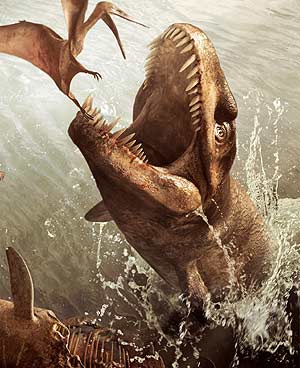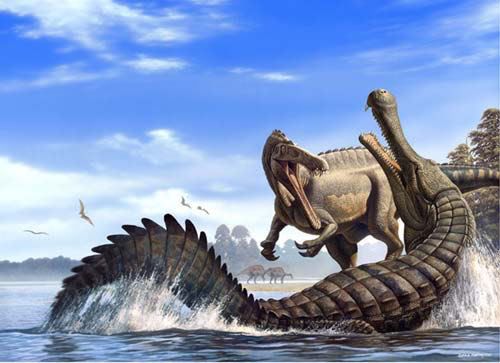crocodiles appeared on earth at the same time as dinosaurs. These reptiles lived at the time at sea. There was a fearsome group of prehistoric hunters, whose relatives still live in fresh water today. If you happen to swim in a prehistoric sea, they serve lunch. Were marine crocodiles.
are closely related to dinosaurs, and at one time lived together. Crocodiles survived the disaster marking the end of the dinosaurs. Today, retain their original shape almost unchanged.
 There are currently 22 species of crocodiles, including crocodiles themselves, American alligators and gharials India. Together they form the crocodilian family. Are survivors of a group that is spread over the planet and after the age of dinosaurs.
There are currently 22 species of crocodiles, including crocodiles themselves, American alligators and gharials India. Together they form the crocodilian family. Are survivors of a group that is spread over the planet and after the age of dinosaurs. Where do crocodiles? About 250 million years ago there appeared a new group of reptiles, archosaurs and reptiles dominant. From that large group of animals evolved three others, the pterosaurs in the air, land the dinosaurs and crocodiles in the rivers and swamps.
 A terrible catastrophe wiped out the dinosaurs and pterosaurs at the end of the Cretaceous. The crocodiles were the only survivors, and have barely changed in nearly 200 million years. We can imagine how they lived in prehistoric times.
A terrible catastrophe wiped out the dinosaurs and pterosaurs at the end of the Cretaceous. The crocodiles were the only survivors, and have barely changed in nearly 200 million years. We can imagine how they lived in prehistoric times. Scientists believe that the secret of survival of the crocodiles is because they support the changes. Available eat any animal, whether living or dead. They can move over land and water. Care for their young and help them get started in life. If the environment becomes intolerable, goes dormant under the mud even underwater. Crocodiles have survived because they are not selective eat anything and live more or less everywhere.
Crocodiles have joints that allow them to walk with the front legs outstretched to the sides of the body, but can run on straight legs vertical. Hovering the nostrils and eyes on the water surface, floating logs appear. Have a valve to separate the airways of the digestive, so they can swallow their victims out of the water even without asfixiares.
prehistoric crocodiles were almost certainly cold-blooded animals, like modern crocodiles, always ready to act. If heated too, opened his mouth so that air cooled by the tongue and inside mouth. To have cold blood, spent little energy and were content to eat it once a week.
In a coal mine Bernissart, Belgium, were found together fossils of two crocodiles and 39 Iguanodon. One was called and another Benissartia Goniopholis. In the mine have also found many fossils, fish and plants. Experts are not sure if they died, the two crocodiles were eating dead fish or Iguanodon, but they know that crocodiles were typical.
 Crocodiles can not chew, they do not have sharp teeth. Yours representing a cone shape and serve to hold the prisoner. If an animal bite can not swallow, he is dragged to the bottom, attach it to a log or a rock and tear it to bits and turning on the water. Sometimes, the crocodile waiting for its prey to decompose and soften.
Crocodiles can not chew, they do not have sharp teeth. Yours representing a cone shape and serve to hold the prisoner. If an animal bite can not swallow, he is dragged to the bottom, attach it to a log or a rock and tear it to bits and turning on the water. Sometimes, the crocodile waiting for its prey to decompose and soften. The crocodiles are some excellent parents. The mother lays eggs in nests of sand or among the decaying litter, and cares for them until the young hatch. Then leads to a pond / daycare protects them until they learn to fend for themselves. The crocodiles are reptiles closer to dinosaurs living today. Watching warm, get food and care for their offspring, we can get an idea of \u200b\u200bhow dinosaurs could live in the past.
The first crocodile was one which was called Protosuchus, who lived about 200 million years. During the Cretaceous, the crocodiles were large and numerous. The Deinosuchus was the largest crocodile, it was 15 meters. But there were much smaller crocodiles, like lizards, called atoposáuridos, who lived in the late Jurassic and early Cretaceous. One of the biggest, the Alligatorum, measuring just 49 centimeters long.
The era of the dinosaurs may have been dominated by them, but they certainly were not the only scary creatures at the time. A series of amazing discoveries a team led by Paul Sereno, a paleontologist at the University of Chicago and a National Geographic Explorer, has made clear that another, less known group of animals lived alongside dinosaurs, and sometimes feed on those better-known relatives .
animals in question were crocodiles, which thrived in the marshes of the ancient Sahara 100 million years ago. Sereno found his first specimen of these prehistoric monsters around a decade ago, a species called Sarcosuchus, dubbed SuperCroc : average about 12 feet long and weighed about 7 tons.
Now, in a publication ZooKeys the Serano team announced the discovery of fossils of three new species and two new fossil species known. Along with SuperCroc, adds a virtual collection of ancient crocodiles inhabiting a variety of ecological niches.
 The strangest of these animals is the fact that many of them were glued to the ground like modern crocodiles, but they were upright, and walked with their legs, like modern mammals. "We have an idea of \u200b\u200bhow to be a crocodile as it should be a mammal," Sereno said, "but you have to break down these categories to see what was happening in Africa at that time. "The BoarCroc, for example, measuring 6 feet long, and had three rows of teeth, like a hell boar, which made him what he calls Sereno a" herd of dinosaurs. " With his agile legs, he says, "that thing probably ran out of the water and attacking dinosaurs."
The strangest of these animals is the fact that many of them were glued to the ground like modern crocodiles, but they were upright, and walked with their legs, like modern mammals. "We have an idea of \u200b\u200bhow to be a crocodile as it should be a mammal," Sereno said, "but you have to break down these categories to see what was happening in Africa at that time. "The BoarCroc, for example, measuring 6 feet long, and had three rows of teeth, like a hell boar, which made him what he calls Sereno a" herd of dinosaurs. " With his agile legs, he says, "that thing probably ran out of the water and attacking dinosaurs."
The DogCroc, in contrast - the size of a dog with a nose like a dog - eat mostly plants and worms . It could also run, but Sereno suspicion, "probably ran into the water to escape from dinosaurs." The RatCroc also was small and had a similar diet. The DuckCroc, as 1 meter, had a broad snout to find food in shallow water and shore, like a duck, fish and frogs. The PancakeCroc was nicknamed by his broad, flat head, which remained low, with my jaw open, waiting for a dinosaur came into his mouth. "Crocodile today can make dams that are up to 3 times their size if necessary," says Sereno - which means that the 6-meter PancakeCroc could have taken a reasonably large dinosaurs, such as a multi-ton sauropod neck long, example. And SuperCroc, which was probably too heavy to run, and possibly walking near the water's edge, could have taken larger dinosaurs.
Strangely, it was a modern crocodile - an Australian freshwater crocodile known as "Freshy" - that helped Sereno understand how some of the ancient crocodiles behaved. "You can get up and gallop, as opposed to saltwater crocodiles that live nearby," he says. Because many of the ancient crocodiles have legs as "Freshy" but lines such as salty, thought they were good swimmers and runners - a lethal combination that may explain something intriguing about dinosaurs.
"[Dinosaurs] never entered the water 'seriously'" he says. "I never entered the oceans as they did mammals after the asteroid hit. "Maybe it was because the dinosaurs were just afraid of what lurked in the waters, waiting.
The missing link crocodile

